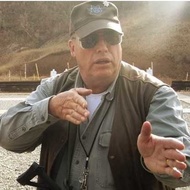31 Mar 2020
Melvin Johnson’s Rifle
Sergie Simonov’s SKS Rifle, first adopted by the Soviets in 1945 (replacing Fedor Tokarev’s short-lived SVT), saw service only until 1952, after which it was superceded by Mikhail Kalashnikov’s AK.
However, the SKS continued to see second-tier service in the USSR, and continuing first-tier service in the PRC (China), for decades afterward. SKSs continued to be manufactured in the USSR until 1958, and a good deal longer than that in the PRC and other countries.
To the Soviets, the SKS represented “fall-back technology,” just in case the new, and relatively radical, AK stumbled! That is why so many SKSs were produced and continued to be produced long after they were considered “outmoded.”
As it turns out, concerns about Kalashnikov’s rifle were groundless. The AK took-off and never looked back, rendering the SKS and SVT more or less instantly obsolete! Today, the AK, manufactured in a hundred different places, is the most ubiquitous military rifle ever known!
Something similar happened in the USA with the Garand and Johnson Rifles.
The Garand Rifle was officially adopted in 1936 and, with world-wide warfare imminent, immediately went into mass production, but the lesser-known Johnson Rifle was also “adopted,” albeit in small numbers, just as insurance in case mass-produced Garands developed unforeseen issues (which they never did).
As it turns out, Melvin Johnson in the late 1930s sold several thousand of his rifles to the Dutch, who were worried about the Japanese invading the Dutch East Indies. Some Johnson rifles reached Holland, and a very few may have actually reached Dutch troops serving in the Dutch East Indies, but the subsequent Japanese invasion was quick and successful, so most of Johnson’s Dutch rifle order was manufactured, but never shipped, and thus remained in the USA
Johnson Rifles were manufactured at a hastily thrown-together factory in Cranston, RI. The sign on the factory said “Johnson Automatics,” although it was also known as “Cranston Arms Co”
US Marines (through some mysterious and unofficial process) ended-up with these stranded Johnsons, took them to the Pacific, and the Johnson Rifle did actually see use with the Marines in some of the early Pacific campaigns. And by all accounts, the Johnson Rifle, during its debut, worked well and was very popular with Marine troopers who carried and used it.
In fact, heroic Marine Captain Robert H Dunlap was awarded the Congressional Medal of Honor for his audacious actions during the battle for Iwo Jima in February and March of 1945, still carrying his Johnson Rifle, which he had apparently kept with him during the entire course of the Pacific Campaign!
Dunlap’s memorial bronze statue, in Monmouth, IL, clearly shows him with Johnson Rifle in hand!
Dunlap brought his Johnson Rifle back from the War and kept it in his home until his death in 2000. John Wayne contacted Dunlap in the 1960s, on behalf of Paramount Pictures. Paramount wanted to make a feature film about Dunlap’s exploits during the War. Dunlap declined!
In the meantime, as large number of Garands were mass-produced, delivered, and also became involved in active fighting in both the European and Pacific Campaigns. Lingering concerns about its functioning and reliability quickly evaporated!
The brief emergence of the Johnson thus ended, and the Johnson Rifle thereafter rapidly faded into military-equipment history.
The Johnson Rifle was short-recoil operated. Curiously, Melvin Johnson was no fan of gas-operated rifles. He considered recoil operation to be superior for military applications.
However, because it was recoil-operated, the Johnson Rifle’s barrel reciprocated with every shot. Thus, when a standard bayonet was attached to the barrel, its weight caused the rifle to short-stroke.
A new and lighter bayonet thus had to be designed in order to ameliorate the problem!
Melvin Johnson died in NYC in 1965.
John C Garand died in Springfield, MA in 1974
Mikhail Kalashnikov died in Izhevsk, Udmurtia (Russia) in 2013
A generation later, Eugene Stoner would borrow heavily from the Johnson Rifle when he designed his AR, that is still with us to this day!
Eugene Stoner died in Palm City, FL in 1997
/John



